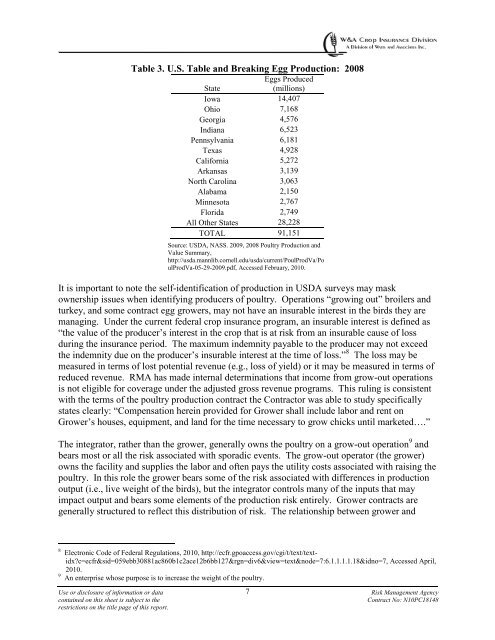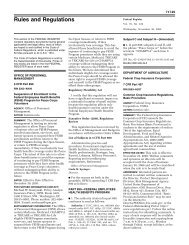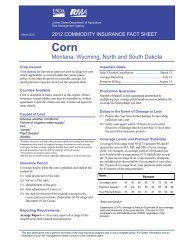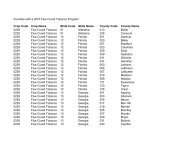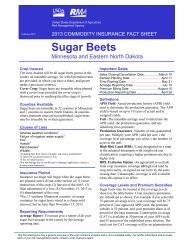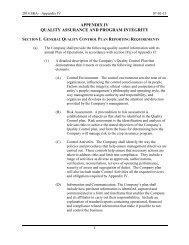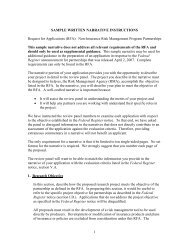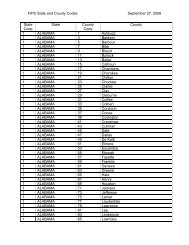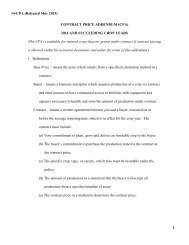Feasibility research report for insuring commercial poultry production
Feasibility research report for insuring commercial poultry production
Feasibility research report for insuring commercial poultry production
Create successful ePaper yourself
Turn your PDF publications into a flip-book with our unique Google optimized e-Paper software.
Table 3. U.S. Table and Breaking Egg Production: 2008Eggs ProducedState(millions)Iowa 14,407Ohio 7,168Georgia 4,576Indiana 6,523Pennsylvania 6,181Texas 4,928Cali<strong>for</strong>nia 5,272Arkansas 3,139North Carolina 3,063Alabama 2,150Minnesota 2,767Florida 2,749All Other States 28,228TOTAL 91,151Source: USDA, NASS. 2009, 2008 Poultry Production andValue Summary,http://usda.mannlib.cornell.edu/usda/current/PoulProdVa/PoulProdVa-05-29-2009.pdf, Accessed February, 2010.It is important to note the self-identification of <strong>production</strong> in USDA surveys may maskownership issues when identifying producers of <strong>poultry</strong>. Operations ―growing out‖ broilers andturkey, and some contract egg growers, may not have an insurable interest in the birds they aremanaging. Under the current federal crop insurance program, an insurable interest is defined as―the value of the producer‘s interest in the crop that is at risk from an insurable cause of lossduring the insurance period. The maximum indemnity payable to the producer may not exceedthe indemnity due on the producer‘s insurable interest at the time of loss.‖ 8 The loss may bemeasured in terms of lost potential revenue (e.g., loss of yield) or it may be measured in terms ofreduced revenue. RMA has made internal determinations that income from grow-out operationsis not eligible <strong>for</strong> coverage under the adjusted gross revenue programs. This ruling is consistentwith the terms of the <strong>poultry</strong> <strong>production</strong> contract the Contractor was able to study specificallystates clearly: ―Compensation herein provided <strong>for</strong> Grower shall include labor and rent onGrower‘s houses, equipment, and land <strong>for</strong> the time necessary to grow chicks until marketed….‖The integrator, rather than the grower, generally owns the <strong>poultry</strong> on a grow-out operation 9 andbears most or all the risk associated with sporadic events. The grow-out operator (the grower)owns the facility and supplies the labor and often pays the utility costs associated with raising the<strong>poultry</strong>. In this role the grower bears some of the risk associated with differences in <strong>production</strong>output (i.e., live weight of the birds), but the integrator controls many of the inputs that mayimpact output and bears some elements of the <strong>production</strong> risk entirely. Grower contracts aregenerally structured to reflect this distribution of risk. The relationship between grower and8 Electronic Code of Federal Regulations, 2010, http://ecfr.gpoaccess.gov/cgi/t/text/textidx?c=ecfr&sid=059ebb30881ac860b1c2ace12b6bb127&rgn=div6&view=text&node=7:6.1.1.1.1.18&idno=7,Accessed April,2010.9 An enterprise whose purpose is to increase the weight of the <strong>poultry</strong>.Use or disclosure of in<strong>for</strong>mation or datacontained on this sheet is subject to therestrictions on the title page of this <strong>report</strong>.7Risk Management AgencyContract No: N10PC18148


